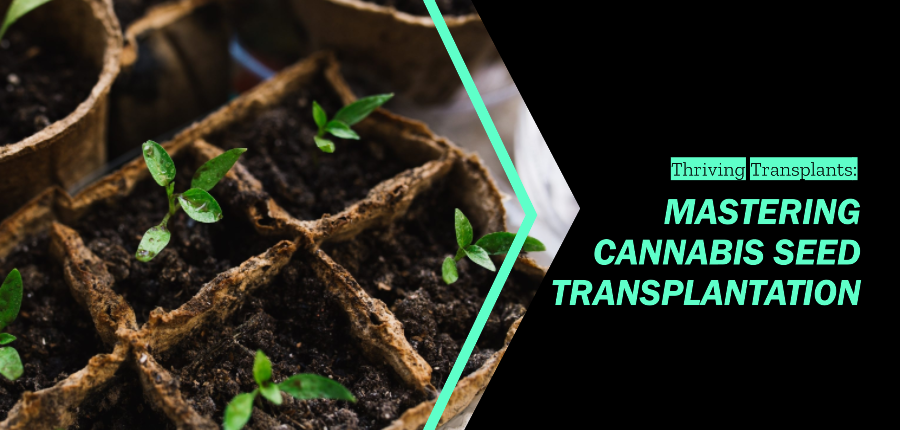Cannabis production has increased significantly as a result of the rising demand for it for both recreational and therapeutic uses. Because of the rising demand, it is necessary to move plants and new soil between different containers to transfer cannabis seeds. Since transplanting cannabis seedlings is essential for promoting healthy and prosperous plant growth, it is essential to comprehend its significance and benefits.
A crucial stage in encouraging the best possible growth of cannabis seeds is transplantation. These young plants require particular circumstances that efficiently encourage the development of their root systems. Following a timely transplanting schedule gives the seedlings enough room and nutrients to promote growth. By reducing the negative impacts of crowding and resource competition, this procedure dramatically improves the growth of cannabis plants. Also, moving the seedlings into larger containers expands their roots, improving fertilizer, water uptake, and soil absorption. As a result, the plant’s general health and vigor are considerably improved.
Things To Know Before Cannabis Seeds Transplantation
Carefully select containers of suitable size and appropriate materials:
Containers should provide sufficient space for seedlings to grow.
Ensure containers have proper drainage to prevent waterlogging.
Containers should allow breathability and ample airflow to prevent root rot.
Prepare the soil or growing medium before transplantation:
Choose nutrient-rich soil or medium with excellent drainage.
Maintain soil pH levels between 6.0 to 7.0 for optimal nutrient absorption.
Incorporate compost, perlite, or vermiculite to enhance nutrient content.
Consider timing for transplantation:
Select seedlings with well-developed roots and two to three sets of leaves.
Ensure proper timing to avoid stunted growth and promote thriving.
Provide pre-transplantation care to seedlings:
Water and feed seedlings appropriately to maintain overall health.
Maintain appropriate moisture levels for strong root establishment.
Avoid overwatering to prevent waterlogging and root rot.
Regularly monitor and adjust watering practices for optimal soil moisture.
Use balanced fertilizer to support healthy growth and development.
Consistently provide diligent care throughout the transplantation process:
Create favorable conditions for successful growth and development.
Comprehensive Guide to Transplanting Cannabis Seeds
To achieve successful transplantation and promote the healthy growth of cannabis seedlings, it is essential to follow the following steps:
1. Prepare the growing medium:
Use a nutrient-rich medium with good drainage properties.
Ensure the medium provides the necessary nutrients for the seedlings’ growth.
2. Prepare the container:
Add soil to the container, leaving sufficient space for the seedling’s root ball.
Create a hole in the center of the soil that can accommodate the delicate root ball without causing damage.
3. Handle the seedling with care:
Extract the seedling from its previous container, not harming or disturbing the roots.
4. Plant the seedling:
Place the seedling into the prepared hole, ensuring the surrounding soil adequately covers the root ball.
5. Water the seedling:
Water the seedling cautiously, avoiding excessive saturation.
Maintain a moist soil environment without overwatering, which can lead to issues like root rot.
6. Provide suitable conditions:
Position the container in a location that receives abundant light, ensuring the seedling receives sunlight.
Supply the seedlings with appropriate nutrients to support vigorous growth.
7. Monitor and adjust:
Keep a close eye on the seedling during its initial days in the new environment.
Watch for signs of stress, such as wilting, and adjust watering and nutrient levels accordingly.
Common Issues After Transplantation
Addressing common problems encountered by cannabis seedlings after transplantation involves effective management strategies. Here are rephrased paragraphs with changed wording, sentence order, and bullet points:
Transplantation Shock:
Minimize the impact of transplant shock through various strategies:
Create a stable environment.
Temporarily adjust water and nutrient intake.
Reduce physical disturbances.
Prevent waterlogging.
Address underwatering and nutrient deficiencies.
Promptly resolve identified issues.
One effective approach is to:
Move the seedlings to a shaded area.
Reduce direct sunlight exposure.
Create a stress-free environment for adaptation.
Overwatering:
Prevent waterlogging by:
Avoiding overwatering.
Reducing watering frequency.
Allowing soil to partially dry out between waterings.
Ensuring proper container drainage.
Using well-draining soil and containers with drainage holes.
Promoting good airflow to prevent excessive moisture buildup.
Underwatering:
Address signs of underwatering by:
Increasing watering frequency.
Maintaining adequate soil moisture.
Incorporating mulch or moisture-retaining substances.
Preventing rapid evaporation.
Nutrient Deficiencies:
Address nutrient deficiencies by:
Supplementing necessary nutrients with fertilizers or organic amendments.
Adjusting soil pH within the optimal range of 6.0-7.0.
Enhancing nutrient uptake and resolving potential deficiencies.
Regular Monitoring and Adaptation:
Monitor seedling growth for signs of stress, nutrient deficiencies, or pests.
Remain adaptable to environmental factors and make necessary adjustments:
Modify lighting, temperature, and humidity levels.
Create an optimal growing environment.
Promptly address problems or issues:
Mitigate identified issues.
Provide necessary care for healthy seedling development after transplantation.

